
By Amanda Ombeva, SC4CCM Regional Technical Advisor

HEWs in Ethiopia travel to the health center to receive products for their patients
There is a lot of misplaced emotion associated with the terms pulling versus pushing of health care commodities. When we envision a health care worker who has pulled commodities we usually think of an empowered spunky health worker who has the right information on his consumption trends and the right tools at hand to calculate his order. Using his records the health worker is able to order his products and get precisely what he needs to serve patients. Conversely my mental picture of a health worker who is getting products pushed to them is that of a bowed and broken spirit opening up his boxed up order form the higher level and wondering why on earth he has received boxes and boxes of injectables with not a single syringe to inject them.
A recent trip I made to Ethiopia to study the Integrated Pharmaceutical Logistics System there dispelled those ideas. In the public health system for pharmaceutical commodity management, regional warehouses called hubs order commodities from a central store. This is ideally the pull system at its purest. Health centres follow suit by placing an order at the hub. For the majority of the essential medicines the health centre pays for the products it receives, therefore pulling the health products too. However each health centre has five or six health posts associated with it that come up to get products from the health centre on a monthly basis.
At the health centre the lines between push and pull begin to get a little blurry. A good logistician will tell you that in the pull system the person placing the order calculates the quantity to be resupplied and for the push system the person fulfilling or issuing the order calculates the quantity to be resupplied. An even better logistician (which I am) will tell you that in both cases the order has to be calculated based on data; i.e., the person calculating the order has to know how much has been consumed and how much is still on hand in order to arrive at a good approximation of how much is needed by the receiving facility. The twist for the Ethiopian IPLS system is that a Health Extension Worker in need of products will travel to a health centre with data on the amount consumed and on hand. The health centre is supposed to make a calculation to decide how much product to issue to the health extension worker. Sometimes though, the decision is made by both the health centre staff and the health extension workers as they make the calculations together. I wonder what you call that system is this the pullsh?? (I really hope that’s not a bad word in any language), the informed push. Personally I am going with the pullsh, a Google search for pullsh yields some really great kettle bells and gear so unfortunately someone has beaten me on the neologism. There is hope yet pullsh is yet to make it into the Oxford Dictionary.
My submission:
Pullsh: (noun) the act of calculating the order quantity to be resupplied where the person supplying the order and the person receiving the data are in the same room participate and look at data to arrive at order quantity.
Pause. (I have tears in my eyes – my 15 seconds of fame passed all too quickly).
Back to Ethiopia and the IPLS system. The reason why the pullsh works for them is that at the service provider level the system is as simple as possible to keep HEWs working with the patients and in the community. When you travel up to the health centre you will frequently find a dedicated pharmacy store manager who has the motivation and ability to perform all the calculations necessary, as long as he has the data.
I have to say the Ethiopians love the pullsh. On the receiving end of the pullsh you have a health extension worker who knows she contributes to receiving appropriate medicines from the record she keeps. Exit pushed health care worker, enter pullshed health care worker (those kettle bells are suddenly starting to make sense). A hub manager in Bahir Dar says the IPLS system has really increased accountability for commodities at the health post. The Health Extension Workers know someone will be looking at the data and are careful to account for all the medicines. It is a lot better than the kit system…which some people call a push system. But that’s a story for another day……

